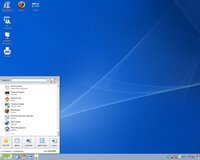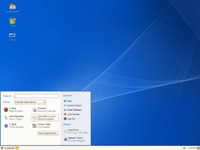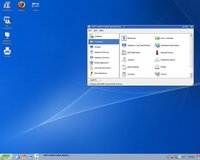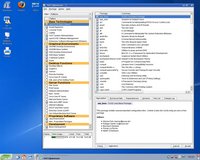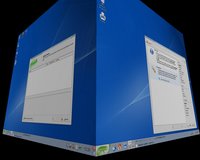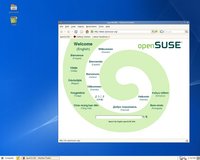OpenSUSE News/10.2-Release
After lot of work, we proudly announce the availability of openSUSE 10.2, formerly known as SUSE Linux 10.x
It's available for download in x86, x86-64, and PPC versions. See below for download details.
Available in openSUSE 10.2
Redesigned Desktops
This release saw the birth of several redesigns in the new and powerful KDE 3.5.5 and GNOME 2.16.1 desktop environments.
Kickoff is the new usability and productivity-centric KDE Menu designed by openSUSE. It comes as the result of extensive start menu research, examining work-flow, functionality, and simplicity. As a user you now have direct access to your favourite and most used applications, your application and document history, as well as a complete and grouped list of all your applications.Kickoff is also integrated with Kerry Beagle, a KDE front-end to the Beagle search tool, for quick-and-easy access to applications, documents, chat logs, and much more.
The GNOME desktop also contains the latest innovations from SUSE Linux Enterprise Desktop, including a new, re-structured menu. It was created with a "Design First" methodology. Engineers conducted hundreds of usability tests and shot almost 1500 hours of usability video during the design phase of the project then used those results to create the final desktop designs. The results are reflected in the final version of the desktop: a new graphical user interface, integrated search capabilities and intuitive menu design.
A few more screenshots of KDE and GNOME in openSUSE 10.2 can be seen here.
YaST (Administrator Settings)
This release contains the powerful and constantly-improving YaST control center. YaST is there to ensure that even the most demanding tasks -- such as setting up a HTTP Server, Configuring your Network Card, handling BlueTooth Devices, managing Software, or even configuring your Monitor and Graphics Card -- can be accomplished trivially with an easily-accessible interface, and simple walk-through wizards.
Plug up a printer and it'll be auto-detected and ready for configuration; hook up a bluetooth device and YaST has the relevant applications ready. Whatever piece of hardware you're dealing with, it will likely be very well supported by YaST. For more information on YaST's capabilities and modules, see the wiki entry.
Power Management
Power management in openSUSE 10.2 has seen some major changes. New power management features give you the option to "suspend" your session, saving it to disk or to RAM. Not only does suspend allow you to turn off and restart the system faster, but when you do restart, you are exactly where you were when you stopped.
We now ship the latest KPowersave, as well: a small panel applet which allows you to control all power management functions supported by your system with just a few clicks on the desktop. You can track power consumption and CPU frequency, or choose another power management scheme to match the tasks your system faces. Configure suspend permissions via a call of the YaST Power Management module and send your system into suspend or standby state by just clicking the applet.
New Software Management
SUSE Linux 10.1 saw some problems with package management, mainly due to the integration of ZMD, the new package management system introduced in that release. For openSUSE 10.2, not only have these issues been resolved, but you are given the option of choosing an entirely different package management suite: the openSUSE Software Management suite, which is completely independent of ZMD.
The openSUSE Software Management pattern is designed to be a lightweight package management system for users who do not require the full ZMD functionality. It comes complete with the full YaST software management front-end, but also has a solid commandline tool, named Zypper. Zypper allows you to quickly install and remove packages, as well as add new services (repositories), without having to leave your terminal. A new KDE applet, opensuseupdater, runs in the System Tray and notifies you when updates are available, allowing you to quickly start YaST Online Update to retrieve them.
All software is now also sorted into Patterns, removing the hassle from tracking down the packages belonging to a particular group. This way you can install an alternative desktop environment, development tools, or try out selections of the latest software with ease.
Desktop Effects
Compiz is a window manager taking advantage of the amazing capabilities of OpenGL. This new window manager developed by Novell engineers provides true transparency (even for playing video media), wobbly windows, an amazing desktop cube effect (as displayed in picture), and much, much more.
Both Compiz and Xgl come on the 10.2 CDs ready for installation. openSUSE 10.2 also ships with the latest Xorg 7.2, which allows you to run Compiz and other composite window managers without having to use Xgl, should you wish to.
openSUSE Build Service
The openSUSE CDs come with thousands of packages, but should you want more there are many more available in the online repository, and there are thousands more packages available in the openSUSE Build Service.
The openSUSE Build Service is an open and complete distribution development platform that provides infrastructure for the development of future openSUSE-based distributions. It provides software developers with a tool to compile, release, and publish their software for the broad user audience, including creation of their own Linux distribution based on openSUSE for various hardware architectures.
Here you can find all of the latest cutting edge technology, with a plethora of different packages, such as always the latest version of Beryl, the composite manager, and much more.
Technical Specifications
- Linux kernel 2.6.18.2, using only SMP kernels
- glibc 2.5
- X.Org 7.2rc2
Product_Highlights also lists the major application changes.
Download Now!
There are multiple methods of downloading.
- Via HTTP / FTP from our mirrors
- Via Metalink
- or via BitTorrent
See the download page for all the necessary links.
Available Images
- 5 CDs -- in x86, x86_64 and PPC and versions. Only CD 1-3 is required for a default GNOME/KDE desktop install (in English, French, Italian, Spanish, German, Brazilian Portuguese, Chinese, Japanese and Czech). CD 4-5 provide extra packages.
- Non-OSS Add On CD -- one BiArch (x86/x86_64), and another PPC version. The Non-OSS Add On CD contains packages with closed source or not OSI-compliant license.
- Language Add On CD -- in x86, x86_64 and PPC and versions. Contains extra language packs for other languages. These are af, ar, az, bg, bn, br, bs, ca, cy, el, eo, et, eu, fa, fy, ga, gl, he, hi, hr, is, kk, ko, lt, lv, mk, mn, ms, nds, nn, pa, ro, ru, rw, se, sk, sl, sr, srLatn, ss, sv, ta, tg, tr, uz, vi.
- 1 DVD -- in x86, x86_64 and PPC and versions. The DVD contains the packages of the 5 CDs and the Non-OSS Add On CD. The retail DVD, being a double-layer, contains more packages.
Once you have downloaded the relevant images, you will want to burn them to a disk.
The openSUSE Project
The openSUSE project is a community program promoting the use of Linux everywhere. openSUSE.org provides free, easy access to the world's most usable Linux distribution, openSUSE. The openSUSE project gives Linux developers and enthusiasts everything they need to get started with Linux.
In The Press
You can read some reviews about the newly released openSUSE 10.2 here.
Communicate
You can join the openSUSE community with feedback, support and discussions through several methods. This includes:
- Mailing list. A complete collection on the above page.
- IRC: #suse on Freenode (irc.freenode.net)
- Forums
- Usenet discussion groups
Join us!
